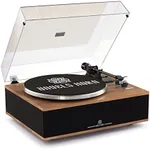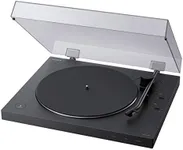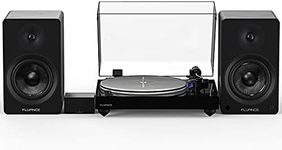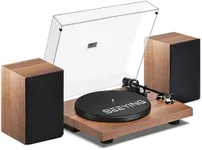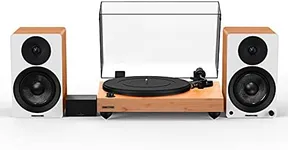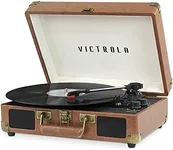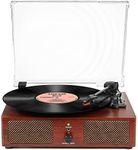Buying Guide for the Best Turntable With Speakers
Choosing a turntable with speakers can be a fun journey, especially if you love music and want to enjoy your vinyl records with ease. The key is to find a setup that matches your listening habits, space, and the kind of sound experience you want. Understanding the main features will help you make a choice that fits your needs, whether you're a casual listener or an aspiring audiophile.Drive TypeThe drive type refers to how the turntable's platter is powered. The two main types are belt-drive and direct-drive. Belt-drive turntables use an elastic belt to spin the platter, which helps reduce vibrations and is often preferred for home listening. Direct-drive turntables have the motor directly under the platter, offering quicker start times and more consistent speed, which DJs often prefer. If you want a quieter, more traditional listening experience, belt-drive is a good choice. If you plan to do any mixing or want a more robust design, direct-drive might suit you better.
Built-in Speakers QualitySince you're looking at turntables with speakers, the quality of those speakers is important. Some turntables have small, basic speakers that are good for casual listening in small rooms, while others offer larger, more powerful speakers for a fuller sound. If you want background music or are limited on space, basic built-in speakers may be enough. If you care about richer sound or plan to listen in larger spaces, look for turntables with higher wattage or the option to connect to external speakers.
Cartridge and Stylus TypeThe cartridge and stylus are the parts that actually touch your records and read the music. There are different types, with moving magnet (MM) being the most common and easy to replace, while moving coil (MC) types are more advanced and expensive. For most users, a standard MM cartridge is reliable and easy to maintain. If you want to upgrade your sound quality later, check if the turntable allows you to swap out the cartridge and stylus.
Speed SettingsTurntables can play records at different speeds, usually 33 1/3, 45, and sometimes 78 RPM. Most modern records are 33 1/3 or 45 RPM, while older records may use 78 RPM. Make sure the turntable you choose supports the speeds of the records you own or plan to buy. If you have a mix of old and new records, a model with all three speeds is most versatile.
Connectivity OptionsConnectivity refers to how you can hook up your turntable to other devices. Some turntables offer Bluetooth, USB, or auxiliary outputs, letting you connect to wireless speakers, computers, or other audio systems. If you want to digitize your records or play music through different speakers, look for these options. If you just want a simple, all-in-one setup, basic built-in speakers may be enough.
Automatic vs. Manual OperationTurntables can be fully manual, semi-automatic, or fully automatic. Manual turntables require you to place the tonearm on the record and lift it off when done. Semi-automatic models return the tonearm at the end of a record, while fully automatic ones handle everything with the push of a button. If you want convenience and ease of use, automatic features are helpful. If you enjoy the hands-on experience and don't mind a bit more effort, manual turntables can be satisfying.
Size and DesignTurntables come in various sizes and styles, from compact, portable units to larger, more classic designs. Consider where you'll place your turntable and how much space you have. If you want something that fits easily on a shelf or desk, look for compact models. If aesthetics matter to you, there are many designs to match your home decor, from retro to modern.

